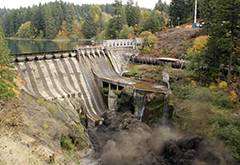Condit Hydroelectric Project was a development on the White Salmon River in the U.S. state of Washington. It was completed in 1913 to provide electrical power for local industry and is listed in the National Register of Historic Places as an engineering and architecture landmark.
PacifiCorp decommissioned the project due to rising environmental costs, and the dam was intentionally breached on October 26, 2011. Condit Dam was the largest dam ever removed in the United States until the Elwha Ecosystem Restoration Project on the Olympic Peninsula removed the larger Elwha Dam and Glines Canyon Dams.
 The White Salmon is a glacier-fed river originating on the slopes of Mount Adams and emptying into the Columbia River. Condit Dam is about 3.3 miles (5.3 km) upstream of the confluence. The area below the dam is part of the Columbia River Gorge National Scenic Area, while parts of the river upstream belong to the National Wild and Scenic Rivers system. The area is famous for its natural environment and recreational activities such as whitewater rafting and fishing. Impoundment of the river in 1911 removed 33 miles (53 km) of steelhead habitat and 14 miles (23 km) of salmon habitat.
The White Salmon is a glacier-fed river originating on the slopes of Mount Adams and emptying into the Columbia River. Condit Dam is about 3.3 miles (5.3 km) upstream of the confluence. The area below the dam is part of the Columbia River Gorge National Scenic Area, while parts of the river upstream belong to the National Wild and Scenic Rivers system. The area is famous for its natural environment and recreational activities such as whitewater rafting and fishing. Impoundment of the river in 1911 removed 33 miles (53 km) of steelhead habitat and 14 miles (23 km) of salmon habitat.
The Condit Hydroelectric project, named after its lead engineer B.C. Condit, was built by Northwestern Electric Company in 1913. During the construction, all 242 workers at the project went on strike and voted unanimously for the strike to be managed by the Industrial Workers of the World. Their demands were twenty-five cent per day pay raise, better food and accommodations, and an end to discrimination against the workers.
Once complete, electricity was primarily supplied to the Crown Willamette Paper Company in Camas, Wa, and surplus power was sold to Portland customers via a power line across the Columbia River. The project was acquired in 1947 by its current owner, PacifiCorp.
The facility consisted of Condit Dam 45°46′02″N 121°32′16″W in Klickitat County, and its impoundment, Northwestern Lake; a woodstave pipeline that transports water to a surge tank and auxiliary spillway; two penstocks and the powerhouse. Two horizontally mounted francis turbines and generators produced electrical power, and the exhausted water rejoined the river about a mile (2 km) downstream of the dam.
The original design had fish ladders which were twice destroyed by floods shortly after the dam's completion. The Washington State Fisheries Department then required Northwestern Electric to participate in a fish hatchery instead of rebuilding the fish ladders. This ended natural salmonid migration on the river. In 1996, the federal government ordered PacifiCorp to alter the dam and add fish ladders to meet environmental codes. PacifiCorp deemed the modifications too expensive and asked to decommission the dam instead. The project operated under annual license extensions until the Federal Energy Regulatory Commission (FERC) approved decommissioning. The dam was breached at noon (Pacific Time) on October 26, 2011. More details
PacifiCorp decommissioned the project due to rising environmental costs, and the dam was intentionally breached on October 26, 2011. Condit Dam was the largest dam ever removed in the United States until the Elwha Ecosystem Restoration Project on the Olympic Peninsula removed the larger Elwha Dam and Glines Canyon Dams.
 The White Salmon is a glacier-fed river originating on the slopes of Mount Adams and emptying into the Columbia River. Condit Dam is about 3.3 miles (5.3 km) upstream of the confluence. The area below the dam is part of the Columbia River Gorge National Scenic Area, while parts of the river upstream belong to the National Wild and Scenic Rivers system. The area is famous for its natural environment and recreational activities such as whitewater rafting and fishing. Impoundment of the river in 1911 removed 33 miles (53 km) of steelhead habitat and 14 miles (23 km) of salmon habitat.
The White Salmon is a glacier-fed river originating on the slopes of Mount Adams and emptying into the Columbia River. Condit Dam is about 3.3 miles (5.3 km) upstream of the confluence. The area below the dam is part of the Columbia River Gorge National Scenic Area, while parts of the river upstream belong to the National Wild and Scenic Rivers system. The area is famous for its natural environment and recreational activities such as whitewater rafting and fishing. Impoundment of the river in 1911 removed 33 miles (53 km) of steelhead habitat and 14 miles (23 km) of salmon habitat.The Condit Hydroelectric project, named after its lead engineer B.C. Condit, was built by Northwestern Electric Company in 1913. During the construction, all 242 workers at the project went on strike and voted unanimously for the strike to be managed by the Industrial Workers of the World. Their demands were twenty-five cent per day pay raise, better food and accommodations, and an end to discrimination against the workers.
Once complete, electricity was primarily supplied to the Crown Willamette Paper Company in Camas, Wa, and surplus power was sold to Portland customers via a power line across the Columbia River. The project was acquired in 1947 by its current owner, PacifiCorp.
The facility consisted of Condit Dam 45°46′02″N 121°32′16″W in Klickitat County, and its impoundment, Northwestern Lake; a woodstave pipeline that transports water to a surge tank and auxiliary spillway; two penstocks and the powerhouse. Two horizontally mounted francis turbines and generators produced electrical power, and the exhausted water rejoined the river about a mile (2 km) downstream of the dam.